Zones / circles / spheres of influence, control and interest - a model of personal development strategy
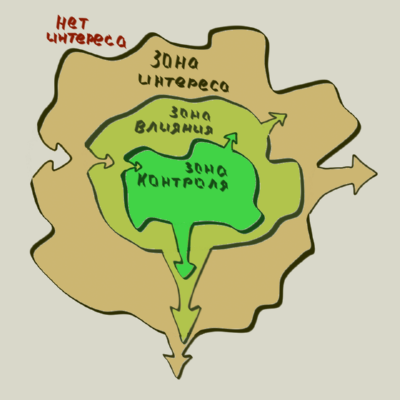 In the last few books, the topic of zones / circles / spheres of influence, control, and interest suddenly began to occur. Moreover, the subject areas of the books were diverse, and the descriptions of the models are very similar.
In the last few books, the topic of zones / circles / spheres of influence, control, and interest suddenly began to occur. Moreover, the subject areas of the books were diverse, and the descriptions of the models are very similar.I wanted to figure it out, the results were quite interesting, and I want to share it.
Request: if you put a minus publication, please indicate in the comments what you did not like.
Versions of the model description
The first and, in my opinion, the simplest model is owned by Stephen Covey and described by him in the " 7 skills of highly effective people" as a tool for determining his degree of pumping in the first skill of highly effective people - proactivity :
')
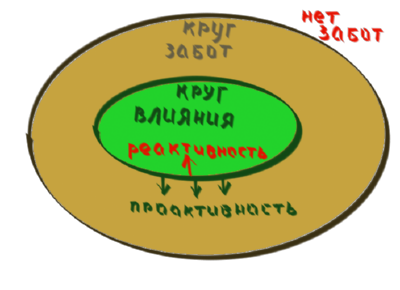
For this purpose, it is proposed to estimate how much time we spend on activities within the “ circle of influence ”, i.e in the zone, things and processes in which we are subject to, and how many in the " zone of care " - the results are interesting to us, but we can not influence them.
A proactive approach (conscious reaction to external events based on personal values, as opposed to impulsive reactions based on feelings, circumstances, conditions dictated by the environment) expands our circle of influence, and then our capabilities.
The second model from Bodo Schaefer from his “ Path to Financial Freedom ” is used by him to illustrate that only by taking responsibility for making a decision, and not blaming others for their failures: genes, parents or the environment, one can achieve success. Actually the idea is the same:
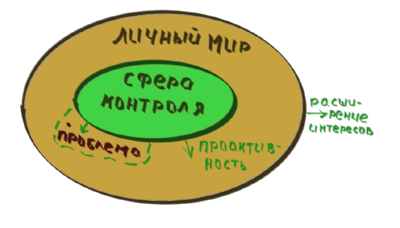
The Circle of Concerns has turned into the Personal World , and the Circle of Influence into the Sphere of Control . If the first pair of concepts is essentially the same, then they differ in the second pair (more on the difference between “influence” and “control” a little later).
But in the resizing mechanisms of the sphere of control / range of influence there are differences. Proactiveness is clearly not called, but the described recommendations are similar:
- “Exit from the comfort zone”, i.e. we create conditions for ourselves and train them to get new results.
- Solve real problems i. we do not think out how to strain ourselves, but our external environment.
- Ask yourself the right questions: “How” instead of “Why” and “Will I be able”, “What can I do” instead of “Who is to blame”, “When” and not “If”
- Expand your personal world, like preparing the ground for finding solutions to problems and getting out of your comfort zone.
The third and last model from William Detmere from Goldratt's Theory of Constraint is used in the analysis of the constructed Tree of Current Reality and consists of:
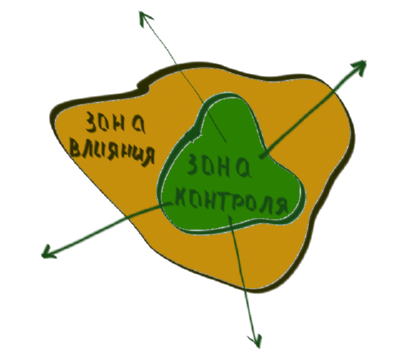
The Zone of Control (“this is an area in which you are the master and are able to change a lot”), the Zone of Influence (this is an area in which you can indirectly, through third parties, influence the result) and the third external area is all that is outside of our interest.
There are no recommendations how to expand (and what should be expanded at all) in the book. But there is a description of concepts, which is not bad complements the first two models.
We collect "our" model
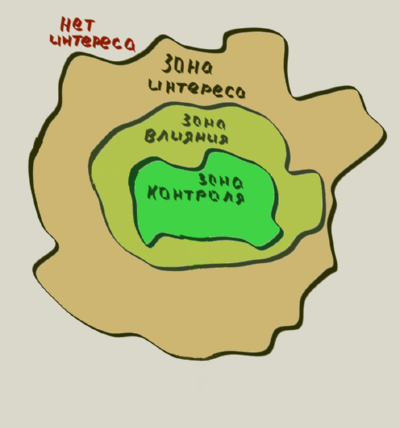
We get 4 zones:
- The control zone is what is in our power, and we are able to get results in it without any help.
For example, a cat in slippers, and in our power to punish him locally or take him to the vet to dramatically remove the harmonious reason for the behavior of the recidivist cat. - The zone of influence is that we can indirectly influence and get the result.
Let's continue the example with the cat, only now the neighbor's cat is shitting us under the door. Here our possibilities are limited. Of course you can catch a cat and punish it, but you can’t take it to the vet anymore, so you have to negotiate with your neighbor. - Zone of interest - we cannot influence the situation, but the course of events is of interest to us.
It is difficult to develop an example with a cat (it is unlikely that it will be very interesting to us that someone’s cat doesn’t shave under our door), so let's take an example with the dollar rate. Yes, it is interesting to us, but we cannot influence it. - No interest - we are not interested in this zone.
The change in the boundaries of zones can be affected by:
- Problem
- Predicting problems and preparing for them
Let's start with usually more urgent, i.e. with problems.

Option 1: The problem arose in the "no interest" zone and we found a solution for it. And why did you decide? There is no interest in it, so the coverage of the zones will not change at all. There is a true possibility that while they have decided, they are interested, but, most likely, we will never solve it.
Option 2: The problem is in the zone of interest and its solution has been found. Consequences - learned to solve, and therefore either gained control over the means of the solution, i.e. added to the control zone, or found with whose help can be solved, i.e. expanded the zone of influence.
Option 3: Solve a problem that fell into the zone of influence. As a result, if we learned a new solution from the control zone, then we expanded the control zone, and if we used the old method through third hands, then nothing has changed.
Option 4: Solved the problem in the control zone. The development is zero, we already could have done it all before.
Option 5: Could not apply a solution to a problem that was considered from the control zone. The result was either they gave the territory to the zone of interest (the old solution did not work, the new could not be found even through the use of third parties), or they were sent to the zone of influence (the solution was still found, but outside of our control).
Option 6: Could not find a solution to the problem from the zone of interest. If they did not lose interest from failure, then nothing has changed, but if they have lost, the zone of interests has shrunk, giving up a piece of the “no interest” zone.
Option 7: There is no solution to the problem outside the zone of interest. Well, no and no. Who is interested in?
Those. the boundaries of the zones are quite a dynamic structure, and they can move not only to expand, but also to narrow ( unpleasant awareness, they did not promise such a guru ):
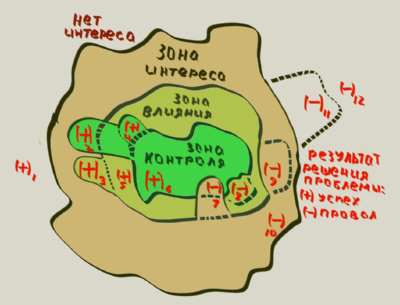
Why wait until the enemy comes to us, let's be proactive and take the territory where the problem will fall in advance, but we will be ready for it. Is it cool?

So, stop, that this is again a loss of territories? There were no unsolved problems, should it only expand?
No, it can not only expand, and this makes it possible to increase its effectiveness. First, at different stages of human life, zones have different sizes. In the first years of life, these zones are very small, with growing up the zones increase, but at some point a person physically and mentally begins to pass and the zones begin to shrink inevitably.
Secondly, not only the expansion, but also the maintenance of each of the zones requires a human resource expenditure, and there are situations when it is necessary to shrink one side to another.
Thirdly, the most resource-cost control zone, because requires constant participation, which is why it is the smallest, the zone of influence of efforts requires less, so it can be kept larger, the zone of interest is even less expensive.
Then why so rarely do those who put all their efforts into the zone of interest succeed? Because the performance of zones decreases to the opposite of the change in resource costs. And the most successful will be the path of balance between fast and costly, medium, slow and inexpensive strategies.
And how to find this balance for maximum efficiency? The answer was given at the very beginning - proactively (consciously based on personal values) to plan their capabilities, combining the performance training with the effectiveness of the chosen directions. And the model of circles / zones / spheres is used as a strategy. As a measurable tool, you can touch the Wheel of Life .
Source: https://habr.com/ru/post/320076/
All Articles